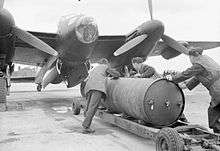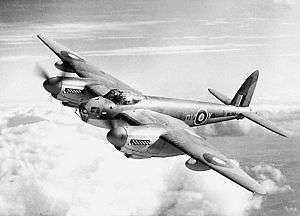No. 692 Squadron RAF
No. 692 Squadron RAF was a light bomber squadron of the Royal Air Force during the Second World War.
| No. 692 (Fellowship of the Bellows) Squadron RAF | |
|---|---|
| Active | 1 January 1944 – 20 September 1945 |
| Country | |
| Branch | |
| Role | Light Bomber Squadron |
| Part of | No. 8 Group RAF, Bomber Command |
| Nickname(s) | Fellowship of the Bellows |
| Motto(s) | Latin: Polus Dum Sidera Pascet (Translation: "So long as the sky shall feed the stars")[1][2] |
| Commanders | |
| Notable commanders | S/Ldr. (then) S.D. Watts, the first pilot to drop a 4,000 lbs "Cookie".[1] |
| Insignia | |
| Squadron Badge heraldry | In front of a pair of wings conjoined in base, a dagger, point downwards[1][2] |
| Squadron Codes | P3 (Jan 1944 – Jun 1945)[3][4][5] |
| Aircraft flown | |
| Bomber | de Havilland Mosquito |
History

The squadron was formed on 1 January 1944 at RAF Graveley, Huntingdonshire as a light bomber unit,[2] equipped with Mosquito Mk.IV bombers, as part of the Light Night Striking Force of No. 8 Group RAF in Bomber Command. It re-equipped with Mosquito Mk.XVI bombers from March 1944 and by June 1944 the squadron had completely switched over to the newer variant.[2][6] It was the first squadron to carry 4,000 lb bombs in Mosquitos,[1] used in an attack on Düsseldorf.[7] The squadron was also the first Mosquito unit to carry out minelaying operations.[7] Most operations were at low level, including one mission when the squadron dropped 4,000 lb bombs into the mouth of tunnels in the Ardennes.[1] At the end of the war the squadron was disbanded on 20 September 1945 at RAF Gransden Lodge, Cambridgeshire.[2][8] The squadron had carried out 3,237 operational sorties (though one source claims a far lower number of sorties, 1,457[9]) for the loss of 17 aircraft.[10]
Aircraft operated
| From | To | Aircraft | Variant |
|---|---|---|---|
| January 1944 | June 1944 | de Havilland Mosquito | Mk.IV |
| March 1944 | September 1945 | de Havilland Mosquito | Mk.XVI |
Commanding officers

| From | To | Name |
|---|---|---|
| January 1944 | March 1944 | W/Cdr. W.G. Lockhart, DSO, DFC |
| March 1944 | July 1944 | W/Cdr. S.D. Watts, DFC (RNZAF) |
| July 1944 | September 1945 | W/Cdr. J. Northrop, DFC, AFC |
Squadron Airfields
| From | To | Name | Remark |
|---|---|---|---|
| 1 January 1944 | 4 June 1944 | RAF Graveley, Huntingdonshire | Formed here |
| 4 June 1944 | 20 September 1945 | RAF Gransden Lodge, Cambridgeshire | Disbanded here |
References
Notes
- Moyes 1976, p. 291.
- Halley 1988, p. 457.
- Bowyer and Rawlings 1979, p. 84.
- Bowyer 1984, p. 142.
- Flintham and Thomas 2003, p. 96.
- Moyes 1976, p. 292.
- Bowyer 1984, p. 132.
- Jefford 2001, p. 106.
- Bowyer 1984, p. 135.
- Falconer 2003, p. 257.
Bibliography
- Bowman, Martin. Mosquito Bomber/Fighter-Bomber Units, 1942–45. Botley, Oxford, UK: Osprey Publishing, 1997. ISBN 978-1-85532-690-3.
- Bowyer, Chaz. Mosquito Squadrons of the Royal Air Force. Shepperton, Surrey, UK: Ian Allan Ltd., 1984. ISBN 0-7110-1425-6.
- Bowyer, Michael J.F. and John D.R. Rawlings. Squadron Codes, 1937–56. Cambridge, UK: Patrick Stephens Ltd., 1979. ISBN 0-85059-364-6.
- Falconer, Jonathan. Bomber Command Handbook, 1939–1945. Stroud, Gloucestershire, UK: Sutton Publishing, 2003. ISBN 0-7509-3171-X.
- Flintham, Vic and Andrew Thomas. Combat Codes: A full explanation and listing of British, Commonwealth and Allied air force unit codes since 1938. Shrewsbury, Shropshire, UK: Airlife Publishing Ltd., 2003. ISBN 1-84037-281-8.
- Halley, James J. The Squadrons of the Royal Air Force and Commonwealth, 1918–1988. Tonbridge, Kent, UK: Air Britain (Historians) Ltd., 1988. ISBN 0-85130-164-9.
- Jefford, C.G. RAF Squadrons: A Comprehensive Record of the Movement and Equipment of All RAF Squadrons and Their Antecedents Since 1912, Shrewsbury, Shropshire, UK: Airlife Publishing, 1988. ISBN 1-85310-053-6. (second revised edition 2001. ISBN 1-84037-141-2.)
- Moyes, Philip J.R. Bomber Squadrons of the RAF and their Aircraft. London: Macdonald and Jane's, 1964 (2nd edition 1976). ISBN 0-354-01027-1.
External links
| Wikimedia Commons has media related to No. 692 Squadron RAF. |
